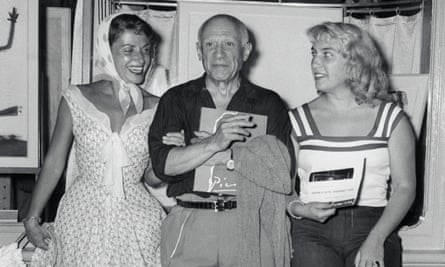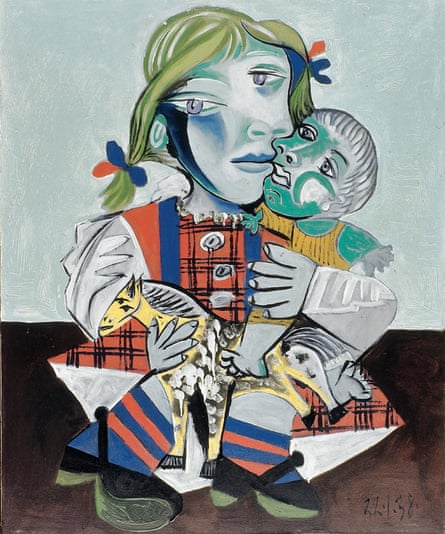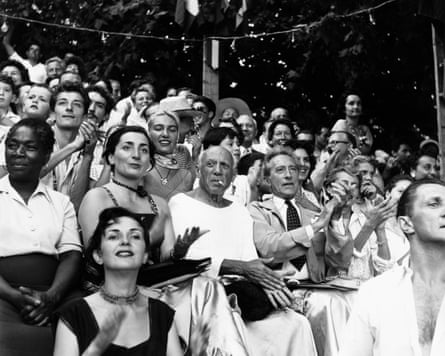Among the more unusual presents the artist Pablo Picasso gave to his elder daughter, Maya, was a box of his nail clippings. These she took to be a token of trust. “My father gave them to me because he was frightened that people would use them against him,” recalled Maya Widmaier-Picasso, who has died of pulmonary failure aged 87. “He was afraid that someone, anyone, would take them and cast a spell on him.”
As with much in the relationship between the Picassos père and fille, the story feels ambiguous. Maya saw the gift as evidence of the bond between them, but it has something of the air of a curse, the clippings part reliquary and part fetish-object. This ambiguity would shape Maya’s life, even after the death of her father in 1973.
She was born Maria de la Concepción in Boulogne-Billancourt, just outside Paris, to Pablo Picasso’s then muse and model, Marie-Thérèse Walter. When Picasso met Walter emerging from a Paris metro station in 1927, he was 48 to her 17: “I was in my prime, she was in her prime,” the painter was blithely to say. He was also married to Olga Khokhlova, a dancer in Diaghilev’s Ballet Russes, with whom he had a five-year-old son, Paulo.

When his first daughter was born, Picasso installed her and her mother in a flat at 44 rue de La Boétie in the 8th arrondissement, diagonally opposite his marital home at number 23. The two households were kept secret from each other, Walter and Maya eventually being moved to Tremblay-sur-Mauldre, west of Paris, in 1937. It was only after the second world war that Maya was told of the existence of Paulo. “One day, Papa said to me, ‘This is your brother,’ she recalled in an interview not long before her death. ‘I was 10 years old.’”
It was not her first experience of the complexities of her father’s love life. Shortly after Maya’s birth, her father had left Walter for the Surrealist photographer Dora Maar. As before, the two women were kept apart, Maar being allowed to visit Picasso’s studio in the morning, Walter in the afternoon. “One day we turned up and she was there, standing next to Guernica,” Maya recalled. “I started crying and said to my father, ‘I don’t want to see the dribbly lady.’ I was talking about Dora Maar, who licked her lips a lot. I never saw her again.”
By now, Picasso was at work on a series of portraits of his daughter marked by the same ambiguity as would colour their relationship as a whole. Maya was to be by far the most frequently painted of her father’s four children, images of her matched in number only by those of his mistresses. Works such as Maya en Tablier (Maya in a Pinafore, 1938) and La Première Neige / Maya (The First Snow / Maya, 1937-38) see the master trying to recapture the innocence of childhood in childlike colours and forms.

Maya recalled of La Première Neige, a pastel: “It was done the day that I took my first steps. I was wearing little pink booties that my father kept all his life.” The image was more than just sentimental, however. As its subject wrote in her memoir, Picasso and Maya: Father and Daughter, published as the catalogue to a show of the same name at Gagosian in New York in 2019: “We would be sitting at the table and suddenly he wanted to immortalise an expression or attitude. He told me, ‘Do not move!’ and he rushed off to find some paper, pencils, a board or notebook. The minutes seemed to last an eternity.”
Whether the intended immortalisation was of a little girl or her father’s genius is a moot point. So, too, Picasso’s insistence on teaching his five-year-old daughter to draw, via a series of study books he made for her by hand and in which Maya struggled to compete with her famous parent. Picasso’s interest seems to have been motivated, at least in part, by the chance of watching his daughter making art so that he could emulate her process in his own. As one curator at the Musée National d’Art Moderne in Paris asked of the books: “Who was learning from whom?”
At 18, Maya was sent to Spain, studying for a year at the Lycée Français in Madrid and then staying on in Barcelona to help a neurologist cousin with the design of orthopaedic corsets. She returned to Paris at 20, taking a job on a feminist magazine and then working as a personal assistant to Josephine Baker, “not merely an extraordinary dancer and actress,” as Maya put it, “but also an activist, a woman who supported civil rights”. In 1960, she married a French naval officer, Pierre Widmaier, with whom she had three children.

Widmaier-Picasso and her two illegitimate siblings sued to be recognised as their father’s heirs on his death, and she also took his additional patronymic of Ruiz. All her children were given the Ruiz-Picasso surname as well as their father’s.
This was not Widmaier-Picasso’s only means of perpetuating her father’s memory. After the death of her older brother, Paulo, in 1975, she set herself up as the principal authority on Pablo Picasso’s work, authenticating many of the nearly 2,000 paintings, 7,000 drawings and 30,000 prints he had left behind. “I think all the expertise she developed was a way for her to continue living with her dad,” her daughter, the art historian Diana Widmaier-Picasso, said.
Maya’s assumption of sole authority led to predictable friction with other claimants to the Picasso mantle, notably with her younger brother, Claude, who also began to authenticate in the 1990s. On occasion, one sibling would declare a work genuine, the other a forgery. In 2012, Claude and three of his fellow heirs announced the setting up of the Picasso Administration as the only authoritative body for the authentication of Pablo Picasso’s works. Maya Widmaier-Picasso was not told of the Administration’s formation, nor was she invited to join it. “I only found out when a friend told me,” she told the American magazine ARTnews. “I nearly died.”

In 2016, she hit the headlines when she appeared to sell Picasso’s 1931 Bust of a Woman – a portrait of her mother – to two buyers at once, one being the Qatari royal family, the other the dealer Larry Gagosian. In the ensuing legal action, allegations were made about Widmaier-Picasso’s mental capacity. The case was settled in Gagosian’s favour.
One work that eluded Widmaier-Picasso was her father’s 1932 portrait of her mother, Le Rêve (The Dream). This had been sold in 1941 to a New York collector, Victor Ganz, who refused to part with it despite increasingly generous offers from its subject’s daughter. “My mother loved Le Rêve so much,” said Diana Widmaier-Picasso, “not only, I think, because it represents her mother, Marie-Thérèse, in all her beauty and happiest days with Pablo, but also because it is an iconic picture of love.” She went on, “With her wonderful sense of humour, my mother suggested that Victor and she should both divorce and marry each other so that they could live with the painting together.”
Maya Widmaier-Picasso is survived by Pierre, and by her children, Olivier, Richard and Diana.

 1 year ago
136
1 year ago
136










 English (US)
English (US)